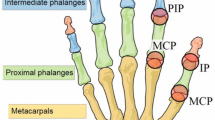Abstract
Hand dysfunction seriously affects patients’ activities of daily life. Rehabilitation exoskeleton can effectively improve the hand function of patients and reduce the burden of their families. However, most of the existing exoskeletons lack the ability to detect the state of hands during rehabilitation, which is a potential safety risk for rehabilitation. In order to improve the safety of hand function rehabilitation training, we proposed a soft wearable exoskeleton equipped with motion perception network. The soft exoskeleton is composed of guided bending bellows actuators, and has good mechanical properties. Besides, the soft bending sensor used to build the perception network has high measurement accuracy. The results showed that the soft exoskeleton with motion perception network not only realizes the full range of finger motion, but also measures the angle of each joint during the movement process. Therefore, this device can improve the rehabilitation effect, avoid secondary injury during rehabilitation training, and meet the rehabilitation needs of patients with hand dysfunction.
Access this chapter
Tax calculation will be finalised at checkout
Purchases are for personal use only
Similar content being viewed by others
References
Aftabi, H., Nasiri, R., Ahmadabadi, M.N.: Simulation-based biomechanical assessment of unpowered exoskeletons for running. Sci. Rep. 11(1), 11846 (2021). https://doi.org/10.1038/s41598-021-89640-3
Ambrosini, E., Ferrante, S., Rossini, M., et al.: Functional and usability assessment of a robotic exoskeleton arm to support activities of daily life. Robotica 32(8), 1213–1224 (2014). https://doi.org/10.1017/S0263574714001891
Wang, W., Zhang, J., Kong, D., et al.: Research on control method of upper limb exoskeleton based on mixed perception model. Robotica 40(10), 3669–3685 (2022). https://doi.org/10.1017/S0263574722000480
Daratany, C., Taveira, A.: Quasi-experimental study of exertion, recovery, and worker perceptions related to passive upper-body exoskeleton use during overhead, low force work, pp. 369–373. Springer International Publishing (2020). https://doi.org/10.1007/978-3-030-44267-5_55
Proietti, T., O’Neill, C., Hohimer, C.J., et al.: Sensing and control of a multi-joint soft wearable robot for upper-limb assistance and rehabilitation. IEEE Robot. Autom. Lett. 6(2), 2381–2388 (2021). https://doi.org/10.1109/LRA.2021.3061061
Moyon, A., Poirson, E., Petiot, J.-F.: Experimental study of the physical impact of a passive exoskeleton on manual sanding operations. Procedia CIRP 70, 284–289 (2018). https://doi.org/10.1016/j.procir.2018.04.028(28thCIRPDesignConference23-25May2018Nantes)
Duanmu, D., Wang, X., Li, X., et al.: Design of guided bending bellows actuators for soft hand function rehabilitation gloves. Actuators (2022)
Peng, X., Acosta-Sojo, Y., Wu, M.I., et al.: Actuation timing perception of a powered ankle exoskeleton and its associated ankle angle changes during walking. IEEE Trans. Neural Syst. Rehabil. Eng. 30, 869–877 (2022). https://doi.org/10.1109/TNSRE.2022.3162213
Graser, J.V., Prospero, L., Liesch, M., et al.: Test-retest reliability of upper limb robotic exoskeleton assessments in children and youths with brain lesions. Sci. Rep. 12(1), 16685 (2022). https://doi.org/10.1038/s41598-022-20588-8
Fanti, V., Sanguineti, V., Caldwell, D.G., et al.: Assessment methodology for human-exoskeleton interactions: kinetic analysis based on muscle activation. Front. Neurorobot. 16, 982950 (2022). https://doi.org/10.3389/fnbot.2022.982950
Mochizuki, G., Centen, A., Resnick, M., et al.: Movement kinematics and proprioception in post-stroke spasticity: assessment using the Kinarm robotic exoskeleton. J. Neuroeng. Rehabil. 16(1), 146 (2019). https://doi.org/10.1186/s12984-019-0618-5
Louie, D.R., Mortenson, W.B., Lui, M., et al: Patients’ and therapists’ experience and perception of exoskeleton-based physiotherapy during subacute stroke rehabilitation: a qualitative analysis. Disab. Rehab. 1–9 (2021). ahead-of-print. https://doi.org/10.1080/09638288.2021.1989503
Bortole, M., Venkatakrishnan, A., Zhu, F., et al.: The H2 robotic exoskeleton for gait rehabilitation after stroke: early findings from a clinical study. J. Neuroeng. Rehabil. 12(1), 54 (2015). https://doi.org/10.1186/s12984-015-0048-y
Guo, N., Wang, X., Duanmu, D., et al.: SSVEP-based brain computer interface controlled soft robotic glove for post-stroke hand function rehabilitation. IEEE Trans. Neural Syst. Rehabil. Eng. 30, 1 (2022). https://doi.org/10.1109/TNSRE.2022.3185262
Shen, Z., Yi, J., Li, X., et al.: A soft stretchable bending sensor and data glove applications. Robot. Biomimetics 3(1), 22 (2016)
Li, X., Wen, R., Shen, Z., et al.: A wearable detector for simultaneous finger joint motion measurement. IEEE Tran. Biomed. Circ. Syst. 12(3), 644–654 (2018)
Delgado, P., Alekhya, S., Majidirad, A., et al.: Shoulder kinematics assessment towards exoskeleton development. Appl. Sci. 10(18), 6336 (2020). https://doi.org/10.3390/app10186336
Muijzer-Witteveen, H., Sibum, N., van Dijsseldonk, R., et al.: Questionnaire results of user experiences with wearable exoskeletons and their preferences for sensory feedback. J. Neuroeng. Rehabil. 15(1), 1–8 (2018). https://doi.org/10.1186/s12984-018-0445-0
Galofaro, E., D’Antonio, E., Patané, F., et al.: Three-dimensional assessment of upper limb proprioception via a wearable exoskeleton. Appl. Sci. 11(6), 2615 (2021). https://doi.org/10.3390/app11062615
Acknowledgment
This work was supported in part by the National Key Research and Development Program of China (2021YFF0501600); Shenzhen-Hong Kong-Macau Technology Research Programme (Type C. SGDX2019081623201196); Shenzhen Local Science and Technology Development Fund guided by the Chinese Central Government (2021Szvup130).
Author information
Authors and Affiliations
Corresponding author
Editor information
Editors and Affiliations
Rights and permissions
Copyright information
© 2024 The Author(s), under exclusive license to Springer Nature Switzerland AG
About this paper
Cite this paper
Li, X., Duanmu, D., Wang, J., Hu, Y. (2024). Design of a Soft Exoskeleton with Motion Perception Network for Hand Function Rehabilitation. In: Wang, G., Yao, D., Gu, Z., Peng, Y., Tong, S., Liu, C. (eds) 12th Asian-Pacific Conference on Medical and Biological Engineering. APCMBE 2023. IFMBE Proceedings, vol 103. Springer, Cham. https://doi.org/10.1007/978-3-031-51455-5_50
Download citation
DOI: https://doi.org/10.1007/978-3-031-51455-5_50
Published:
Publisher Name: Springer, Cham
Print ISBN: 978-3-031-51454-8
Online ISBN: 978-3-031-51455-5
eBook Packages: EngineeringEngineering (R0)




